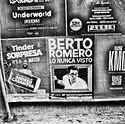NedL
Subscriber
Actually Ned, that would be helpful. I do plan on bringing lots of Acros this summer (need to burn through my stash to make room for the new emulsion, eventually). I normally soup it in Rodinal or Finol (both shot at 80), but I just recently bought some HC-110, something I've never used because 1) it was soooo pricey here in Japan ($80 for 1L!!!), and then 2) it was taken off the market entirely. But I've been wanting to add it to my arsenal of developers so Freestyle Photo recently came to the rescue for me.
I've been using 8m10s at 68°F (= 20°C) for 120 acros in HC-110E ( 10ml syrup + 470ml water ). I start the timer when I start pouring the developer into the tank, and I start pouring it out of the tank 10s before time is up. "Ilford-style" agitation, 4 gentle inversions to start and at the start of each additional minute. My enlarger has a diffusion source, and the negatives that print easily with it look a little more contrasty than other negatives I've seen for a condenser enlarger, but this would probably be a good starting point and you could adjust from there.
Edit: just looked at the acros data sheet. It says acros shot at EI 80 in dilution B at 20°C is 4.5 minutes. That would be close to 7 minutes in dilution E. I'm using 8 minutes and make somewhat contrasty negatives, so that all seems very consistent. I think if you start somewhere between 7 and 8 minutes you'll be in the right ballpark, the negatives will be printable, and you can make minor adjustments from there.
Edit2: A good resource for HC-110 is the covington HC110 page. I use the time adjustment formulas when it's not exactly 20°C ( but close, within 2 or 3 degrees! ) and they seem to work well:
To adjust the development time for a temperature other than the one specified, use these formulae:
New time = Old time × exp(-0.081 × (New temp °C - Old temp °C))
New time = Old time × exp(-0.045 × (New temp °F - Old temp °F))
New time = Old time × exp(-0.081 × (New temp °C - Old temp °C))
New time = Old time × exp(-0.045 × (New temp °F - Old temp °F))
Last edited:










 .
.